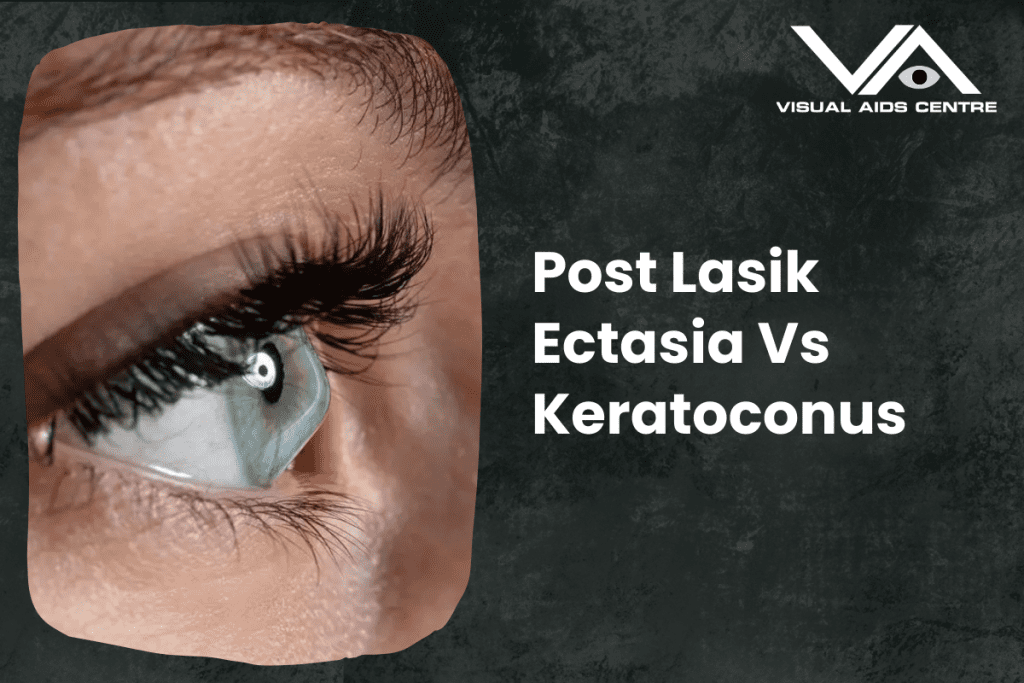Table of Contents
TogglePost LASIK ectasia and keratoconus are progressive eye conditions affecting the cornea, but they have different causes and treatment approaches.
Understanding the differences is crucial for both patients and eye care providers.
Below, we’ll explore both conditions in-depth, differentiate them, and provide valuable insights into their symptoms, causes, diagnosis, and treatment options.

What Is Post LASIK Ectasia?
Post LASIK ectasia, also known as corneal ectasia, is a rare but serious complication that can develop after LASIK surgery. It involves the weakening and bulging of the cornea, leading to a progressive distortion in vision. This condition usually occurs months or years after the surgery and results from a structurally unstable cornea.
Symptoms of Post LASIK Ectasia:
- Blurred vision or difficulty with clarity.
- Increasing astigmatism.
- Sensitivity to light (photophobia).
- Halos or glare around lights, especially at night.
- Fluctuating vision throughout the day.
Important Note: Unlike typical LASIK side effects that improve over time, post LASIK ectasia symptoms progressively worsen without treatment.
Causes of Post LASIK Ectasia:
- Excessive corneal thinning due to the depth of the LASIK surgery.
- Pre-existing conditions such as corneal irregularities not detected before surgery.
- Undiagnosed keratoconus or suspicious corneal topography prior to LASIK, increasing the risk.
- Weakening of the corneal tissue due to the procedure’s reshaping method.
What Is Keratoconus?
Keratoconus is a naturally occurring, progressive eye disease that involves the gradual thinning and bulging of the cornea into a cone-like shape. This results in distorted vision due to irregularities in how light bends as it enters the eye. Unlike post LASIK ectasia, keratoconus arises independently of surgical intervention.
Symptoms of Keratoconus:
- Progressive vision decline that standard prescription glasses or contact lenses have difficulty correcting.
- Increased light sensitivity.
- Ghosting or double vision in one eye.
- Distorted images with reduced contrast.
- Frequent changes in eyeglass prescriptions.
Causes of Keratoconus:
- Genetic predisposition or hereditary factors.
- Environmental triggers such as excessive eye rubbing, are often associated with allergies.
- Biomechanical weakening of corneal collagen fibres (resulting from intrinsic issues rather than surgical alteration).
- Hormonal influence, especially during puberty or pregnancy.
Differences Between Post LASIK Ectasia and Keratoconus
Although post LASIK ectasia and keratoconus share some symptoms and involve corneal weakness, they differ significantly in their origins, clinical presentation, and management approaches. Here’s a detailed comparison:
| Aspect | Post LASIK Ectasia | Keratoconus |
| Cause | Occurs after LASIK surgery due to structural corneal weakening. | Naturally occurring conditions are often due to genetic or environmental factors. |
| Onset | Develops months to years after LASIK surgery. | Typically first noticed during puberty or early adulthood. |
| Progression | Progressive but associated with the procedural impact and corneal stresses of LASIK. | Gradual progression over years, intensifying without timely management. |
| Cornea Shape | Irregular bulging is often tied to surgical reshaping. | Cone-like bulge in the centre or lower part of the cornea. |
| Risk Factors | Includes pre-surgery corneal abnormalities, improper screening, and corneal thinning. | Genetics, eye rubbing, connective tissue disorders. |
| Diagnosis | Detected by corneal topography post-surgery; pachymetry measures residual thickness. | Detected through keratometry, corneal topography, and slit-lamp examination. |
| Treatment Options | Corneal cross-linking, specialised contact lenses, or transplantation in severe cases. | Corneal cross-linking, scleral lenses, and keratoplasty for severe cases. |
Key Diagnostic Differences
Detecting Post LASIK Ectasia
- Corneal topography will show an irregular shape resembling keratoconus but localised around the LASIK flap.
- Thickness mapping (pachymetry) will show areas of significant thinning, particularly post-surgery.
- Advanced diagnostic systems often pinpoint structural abnormalities before dramatic symptoms emerge.
Detecting Keratoconus
- Biomechanical corneal changes appear at a younger age, unrelated to surgery.
- A marked cone-like protrusion and elevated curvature on corneal topography.
- There’s typically no LASIK-related flap or initial thinning predisposing to the condition.
Treatment for Post LASIK Ectasia
Corneal Cross-Linking (CXL)
Corneal cross-linking uses UV light combined with riboflavin drops to strengthen corneal collagen fibres. It halts further weakening and progression.
Specialised Contact Lenses
- Rigid Gas Permeable (RGP) lenses or scleral lenses improve vision by providing a smooth refractive surface.
- Ideal for patients ineligible for additional surgical interventions.
Corneal Transplant (Keratoplasty)
Severe cases where thinning and bulging lead to vision loss may require a corneal transplant to replace damaged tissue.
Treatment for Keratoconus
Corneal Cross-Linking (CXL)
Similar to post LASIK ectasia, it is the first line of defence to stabilise keratoconus progression.
Scleral or Hybrid Contact Lenses
Specialised contact lenses are tailored to accommodate irregular corneal shapes, providing sharp, corrected vision.
Implantation of Corneal Inserts (Intacs)
Intacs are small arcs implanted within the cornea to reshape it and improve vision in mild-to-moderate keratoconus.
Lamellar or Penetrating Keratoplasty
For advanced keratoconus, partial or full-thickness corneal transplants restore the cornea’s normal curvature.
Identifying Risk and Prevention
For Post LASIK Ectasia
Screening for pre-existing conditions like keratoconus or abnormal topography is key. Additional precautions include avoiding excessive LASIK ablation in patients with thin corneas and advising suitable candidates on alternatives like PRK instead of LASIK.
For Keratoconus
Early detection through comprehensive eye exams can greatly slow the progression. Avoiding environmental triggers like habitual eye rubbing and managing allergies aggressively are essential preventive measures.
Why Does Understanding These Differences Matter?
Educated decisions about LASIK: Knowing whether you are at risk for corneal complications, such as ectasia, can help you weigh your LASIK surgery options.
Timely intervention: Early detection of keratoconus or ectasia allows for stabilisation through minimally invasive treatments like corneal cross-linking.
Personalised care: Understanding your condition leads to better communication with your ophthalmologist and ensures access to the most suitable treatments.
Final Thoughts
While post LASIK ectasia and keratoconus share similarities in corneal deformation, they differ fundamentally in cause and management. Accurate diagnosis, timely treatment, and preventive measures can address both conditions effectively and preserve long-term vision.
If you’ve undergone LASIK surgery or suspect you may have keratoconus, seeking advice from a specialist can make all the difference in protecting your eyesight. Always consult an experienced ophthalmologist for accurate diagnosis and tailored treatment options.










